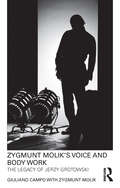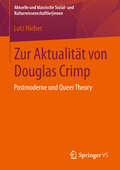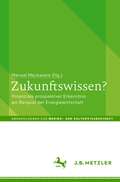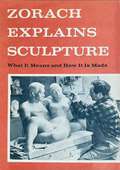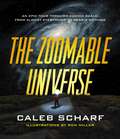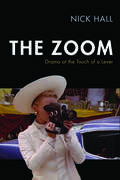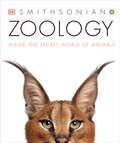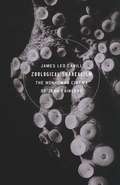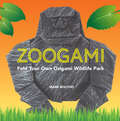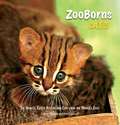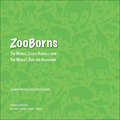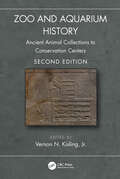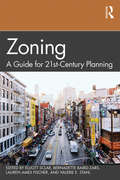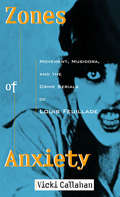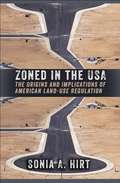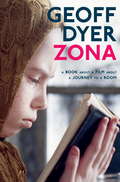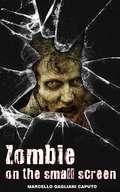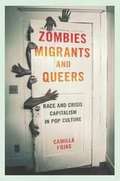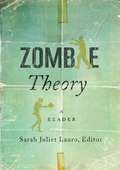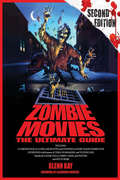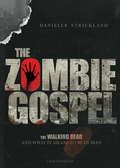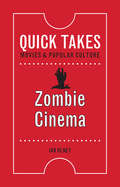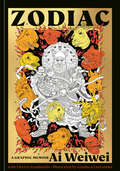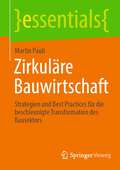- Table View
- List View
Zygmunt Molik's Voice and Body Work: The Legacy of Jerzy Grotowski
by Giuliano Campo Zygmunt MolikOne of the original members of Jerzy Grotowski’s acting company, Zygmunt Molik’s Voice and Body Work explores the unique development of voice and body exercises throughout his career in actor training. This book, constructed from conversations between Molik and author Giuliano Campo, provides a fascinating insight into the methodology of this practitioner and teacher, and focuses on his ‘Body Alphabet’ system for actors, allowing them to combine both voice and body in their preparatory process.
Zur Materialität des feministischen Widerstands: Textile Agency gegen sexualisierte Gewalt und Femicides
by Sarah HeldDie Monographie ist ein feministisch-epistemologischer Beitrag zur Untersuchung kritischer und affektiver Gestaltungsbewegungen. Materielle und visuelle Kultur dienen als interventionistische Kunstpraxis von handarbeitenden Feminist*innen. Hierbei werden die limitierten Zuschreibungen von textilen Handarbeiten und Weiblichkeit in Form von Critical Crafting als politischem Aktivismus dechiffriert. Die ephemeren künstlerischen Erzeugnisse formieren sich zum Widerstand der Dinge und agitieren im (teil) öffentlichen Raum gegen sexualisierte Gewalt und Femicides (Frauenmorde, Neologismus aus Female und Homicide) sowie der damit verbundenen gesellschaftlichen Stigmatisierung von Betroffenen.
Zur Aktualität von Douglas Crimp: Postmoderne und Queer Theory
by Lutz HieberDouglas Crimp war in den 1980er Jahren Mitherausgeber der Zeitschrift October. Er formulierte wesentliche Positionen in der Diskussion um den US-amerikanischen Postmodernismus. Dessen künstlerische Praktiken fasste Crimp als Wiederaufgreifen des unvollendet gebliebenen Projekts der historischen Avantgarden, die Diktatur und Krieg aus Europa vertrieben hatten. In der Aids-Krise, die in der zweiten Hälfte der 1980er Jahre virulent wurde, entstand künstlerischer Aktivismus. Damit änderte sich der Aktionsradius für Crimp, der sich auch in der politischen Bewegung engagierte.
Zukunftswissen?: Potenziale prospektiver Erkenntnis am Beispiel der Energiewirtschaft (Abhandlungen zur Medien- und Kulturwissenschaft)
by Manuel MackasareVorstellungen von der Zukunft bestimmen das menschliche Handeln. In energiewirtschaftlichen Fragen sind solche Antizipationen besonders relevant: Staaten beschließen Förderprogramme, Unternehmen errichten Kraftwerke, Privatpersonen füllen ihre Öltanks oder ersetzen sie durch Wärmepumpen – stets mit Blick auf ein Morgen, der mitunter trügerisch ist. Kontrovers diskutiert wird, ob es ein Wissen von der Zukunft überhaupt geben und inwieweit es Gegenstand der Wissenschaft sein kann. Die Beiträge dieses Bandes untersuchen Möglichkeit, Methoden und Geltung von Zukunftsentwürfen aus philosophischer, historischer, sozial-, literatur- und medienwissenschaftlicher Perspektive.
Zorach Explains Sculpture: What It Means And How It Is Made
by William ZorachAs noted American sculptor William Zorach explains in this practical and inspirational guide, sculpture is a language, as are music and the spoken word. It is one of the great natural means of human expression. In teaching students to explore this valuable medium, he offers lucid, insightful coverage of such topics as form in art, proportions, anatomy, rhythm, design, and other essentials.Students will also find a wealth of practical guidance for building a figure in clay, casting in plaster and stone, wood carving and wood sculpture, stone carving and sculpture, handling stone, and more. Hundreds of drawings and photographs enhance the text, ranging from ancient Greek terra-cottas to 20th-century masterpieces by Lachaise, Maillol, Brancusi, Epstein, and other masters. There are also many helpful drawings and diagrams illuminating various steps and stages in the sculpting process.Brimming with the distilled artistic wisdom of a lifetime, this enormously informative work belongs not only at the fingertips of every sculptor or sculpture student but in the library of anyone interested in the artistic process and how an artist's vision becomes reality.-Print ed.
The Zoomable Universe: An Epic Tour Through Cosmic Scale, from Almost Everything to Nearly Nothing
by Ron Miller Caleb ScharfAn epic, full-color visual journey through all scales of the universeIn The Zoomable Universe, the award-winning astrobiologist Caleb Scharf and the acclaimed artist Ron Miller take us on an epic tour through all known scales of reality, from the largest possible magnitude to the smallest. Drawing on cutting-edge science, they begin at the limits of the observable universe, a scale spanning 10^27 meters—about 93 billion light-years. And they end in the subatomic realm, at 10^-35 meters, where the fabric of space-time itself confounds all known rules of physics. In between are galaxies, stars and planets, oceans and continents, plants and animals, microorganisms, atoms, and much, much more. Stops along the way—all enlivened by Scharf’s sparkling prose and his original insights into the nature of our universe—include the brilliant core of the Milky Way, the surface of a rogue planet, the back of an elephant, and a sea of jostling quarks.The Zoomable Universe is packed with more than 100 original illustrations and infographics that will captivate readers of every age. It is a whimsical celebration of discovery, a testament to our astounding ability to see beyond our own vantage point and chart a course from the farthest reaches of the cosmos to its subatomic depths—in short, a must-have for the shelves of all explorers.
The Zoom: Drama at the Touch of a Lever (Techniques of the Moving Image)
by Nick HallFrom the queasy zooms in Alfred Hitchcock’s Vertigo to the avant-garde mystery of Michael Snow’s Wavelength, from the excitement of televised baseball to the drama of the political convention, the zoom shot is instantly recognizable and highly controversial. In The Zoom, Nick Hall traces the century-spanning history of the zoom lens in American film and television. From late 1920s silent features to the psychedelic experiments of the 1960s and beyond, the book describes how inventors battled to provide film and television studios with practical zoom lenses, and how cinematographers clashed over the right ways to use the new zooms. Hall demonstrates how the zoom brought life and energy to cinema decades before the zoom boom of the 1970s and reveals how the zoom continues to play a vital and often overlooked role in the production of contemporary film and television.
Zoology: Inside the Secret World of Animals (DK Secret World Encyclopedias)
by DKSee the animal kingdom in all its glory, from jellyfish to polar bears, with up-close details of their unique features from head to toe. Filled with magnificent photographs that were specially commissioned for this book and cannot be seen anywhere else. Written in association with the Smithsonian Institution.This visual reference book starts with the question "what is an animal?" and takes you through the animal kingdom - mammals, reptiles, birds, and sea creatures. It uses a unique head-to-toe approach that showcases in spectacular detail special features like the flight feathers of a parrot, the antenna of a moth, or the tentacles of coral.This visual encyclopedia is filled with clear and fascinating information on everything about the social lives of animals. Read exciting stories like how animals communicate, defend their territories, and attract mates.Learn how evolution has helped wildlife to adapt to their unique environments, whether it's the ability to live in difficult habitats, adjust to specific diets, or how they work physically.Humans have drawn and painted animals for thousands of years. Zoology has included some of these, like early rock art that depicts our awe of the animal kingdom or natural history artworks like those commissioned by the Mughal Courts in the 1600s.Dramatic Wildlife PhotographySpectacular, never-before-seen photographs that will bring you close to many of the world's most captivating and intriguing inhabitants. This book offers an extraordinary introduction to the animal world by taking you through chapters that details their diversity.Go from head to toe in Zoology: The animal kingdomShape and sizeSkeletons Skins, coats, and armorSensesMouth and jawsLegs, arms, tentacles, and tailsFins, flippers, and paddlesWings and parachutesEggs and offspring
Zoological Surrealism: The Nonhuman Cinema of Jean Painlevé
by James Leo CahillAn archive-based, in-depth analysis of the surreal nature and science movies of the pioneering French filmmaker Jean PainlevéBefore Jacques-Yves Cousteau, there was Jean Painlevé, a pioneering French scientific and nature filmmaker with a Surrealist’s eye. Creator of more than two hundred films, his studies of strange animal worlds doubled as critical reimaginations of humanity. With an unerring eye for the uncanny and unexpected, Painlevé and his assistant Geneviève Hamon captured oneiric octopuses, metamorphic crustaceans, erotic seahorses, mythic vampire bats, and insatiable predatory insects. Zoological Surrealism draws from Painlevé’s early oeuvre to rethink the entangled histories of cinema, Surrealism, and scientific research in interwar France. Delving deeply into Painlevé’s archive, James Leo Cahill develops an account of “cinema’s Copernican vocation”—how it was used to forge new scientific discoveries while also displacing and critiquing anthropocentric viewpoints. From Painlevé’s engagements with Sergei Eisenstein, Georges Franju, and competing Surrealists to the historiographical dimensions of Jean Vigo’s concept of social cinema, Zoological Surrealism taps never-before-examined sources to offer a completely original perspective on a cutting-edge filmmaker. The first extensive English-language study of Painlevé’s early films and their contexts, it adds important new insight to our understanding of film while also contributing to contemporary investigations of the increasingly surreal landscapes of climate change and ecological emergency.
Zoogami: Fold Your Own Wildlife Park of Origami
by Mark BolithoWorld-renowned origami artist Mark Bolitho presents twenty new origami projects so you can create a wildlife menagerie.With clear step-by-step instructions, diagrams, and photographs of each finished project, Zoogami provides everything you need to know to fold a range of wildlife, from fish to birds, reptiles to big cats. The projects have been designed to inspire and challenge folders of every skill level. Specially designed origami paper that replicates the animals' feathers, fur, and scales is included.
ZooBorns Cats!
by Andrew Bleiman Chris EastlandZooBorns showcases the newest and cutest animal babies from accredited zoos and aquariums around the world. With interesting animal facts and background stories on the featured babies, ZooBorns illustrates the connections between zoo births and conservation initiatives in the wild.
ZooBorns
by Andrew Bleiman Chris EastlandZooBorns showcases the newest and cutest animal babies from accredited zoos and aquariums around the world. With interesting animal facts and background stories on the featured babies, ZooBorns illustrates the connections between zoo births and conservation initiatives in the wild.
Zoo and Aquarium History: Ancient Animal Collections to Conservation Centers
by Vernon N. Kisling Jr.Wild animals have been housed in zoos and aquariums for 5,000 years, fascinating people living in virtually every society. Today, these institutions are at a new milestone in their history. This second edition of Zoo and Aquarium History takes the reader on a journey through the transition of private collections to menageries, to zoos, then zoological gardens, and more recently conservation centers and sanctuaries. Under the direction of Vernon N. Kisling, an expert in zoo history, an international team of authors has thoroughly updated the only comprehensive, global history of animal collections, menageries, zoos, and aquariums. The resulting book documents the continuum of efforts in maintaining wild animal collections from ancient civilizations through today, explaining how modern zoos have developed their mission statements around the core aims of conservation, education, research and recreation. This new edition pulls together regional information, including new chapters on zoological gardens of Canada, Latin America, China, Israel, the Middle East, and New Zealand, along with the cultural aspects of each region to provide a foundation upon which further research can be based. It presents a chronological listing of the world's zoos and aquariums and features many never-before published photographs. Sidebars present supplementary information on pertinent personalities, events, and wildlife conservation issues. The original Appendix has been expanded to include over 1,200 zoos and aquariums, providing an invaluable resource. This is an extensive, chronological introduction to the subject, highlighting the published and archival resources for those who want to know more.
Zoning: A Guide for 21st-Century Planning
by Elliott Sclar Bernadette Baird-Zars Lauren Ames Fischer Valerie E. StahlZoning is at once a key technical competency of urban planning practice and a highly politicized regulatory tool. How this contradiction between the technical and political is resolved has wide-reaching implications for urban equity and sustainability, two key concerns of urban planning. Moving beyond critiques of zoning as a regulatory hindrance to local affordability or merely the rulebook that guides urban land use, this textbook takes an institutional approach to zoning, positioning its practice within the larger political, social, and economic conflicts that shape local access for diverse groups across urban space. Foregrounding the historical-institutional setting in which zoning is embedded allows planners to more deeply engage with the equity and sustainability issues related to zoning practice. By approaching zoning from a social science and planning perspective, this text engages students of urban planning, policy, and design with several key questions relevant to the realities of zoning and land regulation they encounter in practice. Why has the practice of zoning evolved as it has? How do social and economic institutions shape zoning in contemporary practice? How does zoning relate to the other competencies of planning, such as housing and transport? Where and why has zoning, an act of physical land use regulation, replaced social planning? These questions, grounded in examples and cases, will prompt readers to think critically about the potential and limitations of zoning. By reforging the important links between zoning practice and the concerns of the urban planning profession, this text provides a new framework for considering zoning in the 21st century and beyond.
Zones of Anxiety: Movement, Musidora, and the Crime Serials of Louis Feuillade
by Vicki CallahanA feminist analysis of the "cinema of uncertainty" through an examination of the crime serials of Louis Feuillade and the work of actress Musidora.
Zoned in the USA: The Origins and Implications of American Land-Use Regulation
by Sonia A. HirtWhy are American cities, suburbs, and towns so distinct? Compared to European cities, those in the United States are characterized by lower densities and greater distances; neat, geometric layouts; an abundance of green space; a greater level of social segregation reflected in space; and--perhaps most noticeably--a greater share of individual, single-family detached housing. In Zoned in the USA, Sonia A. Hirt argues that zoning laws are among the important but understudied reasons for the cross-continental differences. Hirt shows that rather than being imported from Europe, U.S. municipal zoning law was in fact an institution that quickly developed its own, distinctly American profile. A distinct spatial culture of individualism--founded on an ideal of separate, single-family residences apart from the dirt and turmoil of industrial and agricultural production--has driven much of municipal regulation, defined land-use, and, ultimately, shaped American life. Hirt explores municipal zoning from a comparative and international perspective, drawing on archival resources and contemporary land-use laws from England, Germany, France, Australia, Russia, Canada, and Japan to challenge assumptions about American cities and the laws that guide them.
Zona: A Book About a Film About a Journey to a Room
by Geoff DyerFrom a writer whose mastery encompasses fiction, criticism, and the fertile realm between the two, comes a new book that confirms his reputation for the unexpected.In Zona, Geoff Dyer attempts to unlock the mysteries of a film that has haunted him ever since he first saw it thirty years ago: Andrei Tarkovsky's Stalker, widely regarded as one of the greatest films of all time. ("Every single frame," declared Cate Blanchett, "is burned into my retina.") As Dyer guides us into the zone of Tarkovsky's imagination, we realize that the film is only the entry point for a radically original investigation of the enduring questions of life, faith, and how to live. In a narrative that gives free rein to the brilliance of Dyer's distinctive voice--acute observation, melancholy, comedy, lyricism, and occasional ill-temper--Zona takes us on a wonderfully unpredictable journey in which we try to fathom, and realize, our deepest wishes.Zona is one of the most unusual books ever written about film, and about how art--whether a film by a Russian director or a book by one of our most gifted contemporary writers--can shape the way we see the world and how we make our way through it.
Zombies on the small screen
by Marcello Gagliani Caputo Andrew Bell, MITI, ATA, Dip. PublishingHaving saturated the world of cinema, the zombie has found new, fertile ground on television, where the character has rediscovered its youth. From the success of "The Walking Dead" to the spin-off "Fear the Walking Dead", from the surprise hit "Dead Set" to the poignant "In the Flesh"; from The Asylum's "Z-Nation'" to the romantic delicacy of the French production, "Les Revenants"; this volume includes the best zombie TV series hitting TV screens worldwide, with critical analysis fascinating insights into the genre.
Zombies, Migrants, and Queers: Race and Crisis Capitalism in Pop Culture
by Camilla FojasThe alarm and anxiety unleashed by the Great Recession found fascinating expression across popular culture. Harried survivors negotiated societal collapse in The Walking Dead. Middle-class whites crossed the literal and metaphorical Mexican border on Breaking Bad or coped with a lack of freedom among the marginalized on Orange Is the New Black. Camilla Fojas uses representations of people of color, the incarcerated, and trans/queers--vulnerable populations all--to work through the contradictions created by the economic crisis and its freefalling aftermath. Television, film, advertising, and media coverage of the crisis created a distinct kind of story about capitalism and the violence that supports it. Fojas shows how these pop culture moments reshaped social dynamics and people's economic sensibilities and connects the ways pop culture reflected economic devastation. She also examines how these artifacts illuminated parts of society usually kept off-screen or on the margins even as they defaulted to stories of white protagonists.
Zombie Theory: A Reader
by Sarah Juliet LauroZombies first shuffled across movie screens in 1932 in the low-budget Hollywood film White Zombie and were reimagined as undead flesh-eaters in George A. Romero’s The Night of the Living Dead almost four decades later. Today, zombies are omnipresent in global popular culture, from video games and top-rated cable shows in the United States to comic books and other visual art forms to low-budget films from Cuba and the Philippines. The zombie’s ability to embody a variety of cultural anxieties—ecological disaster, social and economic collapse, political extremism—has ensured its continued relevance and legibility, and has precipitated an unprecedented deluge of international scholarship. Zombie studies manifested across academic disciplines in the humanities but also beyond, spreading into sociology, economics, computer science, mathematics, and even epidemiology. Zombie Theory collects the best interdisciplinary zombie scholarship from around the world. Essays portray the zombie not as a singular cultural figure or myth but show how the undead represent larger issues: the belief in an afterlife, fears of contagion and technology, the effect of capitalism and commodification, racial exclusion and oppression, dehumanization. As presented here, zombies are not simple metaphors; rather, they emerge as a critical mode for theoretical work. With its diverse disciplinary and methodological approaches, Zombie Theory thinks through what the walking undead reveal about our relationships to the world and to each other.Contributors: Fred Botting, Kingston U; Samuel Byrnand, U of Canberra; Gerry Canavan, Marquette U; Jeffrey Jerome Cohen, George Washington U; Jean Comaroff, Harvard U; John Comaroff, Harvard U; Edward P. Comentale, Indiana U; Anna Mae Duane, U of Connecticut; Karen Embry, Portland Community College; Barry Keith Grant, Brock U; Edward Green, Roosevelt U; Lars Bang Larsen; Travis Linnemann, Eastern Kentucky U; Elizabeth McAlister, Wesleyan U; Shaka McGlotten, Purchase College-SUNY; David McNally, York U; Tayla Nyong’o, Yale U; Simon Orpana, U of Alberta; Steven Shaviro, Wayne State U; Ola Sigurdson, U of Gothenburg; Jon Stratton, U of South Australia; Eugene Thacker, The New School; Sherryl Vint, U of California Riverside; Priscilla Wald, Duke U; Tyler Wall, Eastern Kentucky U; Jen Webb, U of Canberra; Jeffrey Andrew Weinstock, Central Michigan U.
Zombie Movies: The Ultimate Guide
by Glenn Kay Alejandro BruguésFeaturing chronological reviews of more than 300 zombie films--from 1932's White Zombie to the AMC series The Walking Dead--this thorough, uproarious guide traces the evolution of one of horror cinema's most popular and terrifying creations. Fans will learn exactly what makes a zombie a zombie, go behind the scenes with a chilling production diary from Land of the Dead, peruse a bizarre list of the oddest things ever seen in undead cinema, and immerse themselves in a detailed rundown of the 25 greatest zombie films ever made. Containing an illustrated zombie rating system, ranging from "Highly Recommended" to "Avoid at All Costs" and "So Bad It's Good," the book also features lengthy interviews with numerous talents from in front of and behind the camera. This updated and expanded second edition contains more than 100 new and rediscovered films, providing plenty of informative and entertaining brain food for movie fans.
The Zombie Gospel: The Walking Dead and What It Means to Be Human
by Danielle StricklandThe Walking DeadThe Zombie GospelThe Walking DeadThe Walking Dead
Zombie Cinema
by Ian OlneyIt’s official: the zombie apocalypse is here. The living dead have been lurking in popular culture since the 1930s, but they have never been as ubiquitous or as widely-embraced as they are today.Zombie Cinema is a lively and accessible introduction to this massively popular genre. Presenting a historical overview of zombie appearances in cinema and on television, Ian Olney also considers why, more than any other horror movie monster, zombies have captured the imagination of twenty-first-century audiences. Surveying the landmarks of zombie film and TV, from White Zombie to The Walking Dead, the book also offers unique insight into why zombies have gone global, spreading well beyond the borders of American and European cinema to turn up in films from countries as far-flung as Cuba, India, Japan, New Zealand, and Nigeria. Both fun and thought-provoking, Zombie Cinema will give readers a new perspective on our ravenous hunger for the living dead.
Zodiac: A Graphic Memoir
by Ai WeiweiIn this beautifully illustrated and deeply philosophical graphic memoir, legendary artist Ai Weiwei explores the connection between artistic expression and intellectual freedom through the lens of the Chinese zodiac.As a child living in exile during the Cultural Revolution, Ai Weiwei often found himself with nothing to read but government-approved comic books. Although they were restricted by the confines of political propaganda, Ai Weiwei was struck by the artists&’ ability to express their thoughts on art and humanity through graphic storytelling. Now, decades later, Ai Weiwei and Italian comic artist Gianluca Costantini present Zodiac, Ai Weiwei&’s first graphic memoir.Inspired by the twelve signs of the Chinese zodiac and their associated human characteristics, Ai Weiwei masterfully interweaves ancient Chinese folklore with stories of his life, family, and career. The narrative shifts back and forth through the years—at once in the past, present, and future—mirroring memory and our relationship to time. As readers delve deeper into the beautifully illustrated pages of Zodiac, they will find not only a personal history of Ai Weiwei and an examination of the sociopolitical climate in which he makes his art, but a philosophical exploration of what it means to find oneself through art and freedom of expression.Contemplative and political, Zodiac will inspire readers to return again and again to Ai Weiwei&’s musings on the relationship between art, time, and our shared humanity.
Zirkuläre Bauwirtschaft: Strategien und Best Practices für die beschleunigte Transformation des Bausektors (essentials)
by Martin PauliDieses Essential fasst prägnant zusammen, warum die Prinzipien der Kreislaufwirtschaft für die Bauwirtschaft im Kontext von Klimawandel und zunehmender Ressourcenknappheit unabdingbar sind. Es gibt Einblicke in Umsetzungsstrategien und Projektbeispiele, beleuchtet die elementaren Methoden zur Messbarkeit von sektorspezifischen CO2-Emissionen und wirft einen systemischen Blick auf die Wertschöpfungskette Bau sowie die Implikationen, Potenziale und Risiken der Umsetzung.
